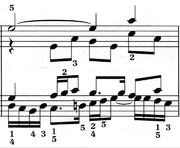
Part (music)
Encyclopedia

Melody
A melody , also tune, voice, or line, is a linear succession of musical tones which is perceived as a single entity...
of music
Music
Music is an art form whose medium is sound and silence. Its common elements are pitch , rhythm , dynamics, and the sonic qualities of timbre and texture...
played by an individual instrument
Musical instrument
A musical instrument is a device created or adapted for the purpose of making musical sounds. In principle, any object that produces sound can serve as a musical instrument—it is through purpose that the object becomes a musical instrument. The history of musical instruments dates back to the...
or voice (or group of identical instruments or voices) within a larger work. Parts may be referred to as an outer part (the top and bottom parts) or an inner part (those in between). Part-writing (or voice leading
Voice leading
In musical composition, voice leading is the term used to refer to a decision-making consideration when arranging voices , namely, how each voice should move in advancing from each chord to the next.- Details :...
) is the composition of parts in consideration of harmony
Harmony
In music, harmony is the use of simultaneous pitches , or chords. The study of harmony involves chords and their construction and chord progressions and the principles of connection that govern them. Harmony is often said to refer to the "vertical" aspect of music, as distinguished from melodic...
and counterpoint
Counterpoint
In music, counterpoint is the relationship between two or more voices that are independent in contour and rhythm and are harmonically interdependent . It has been most commonly identified in classical music, developing strongly during the Renaissance and in much of the common practice period,...
. In the context of polyphonic
Polyphony
In music, polyphony is a texture consisting of two or more independent melodic voices, as opposed to music with just one voice or music with one dominant melodic voice accompanied by chords ....
composition the term voice may be used instead of part to denote a single melodic
Melody
A melody , also tune, voice, or line, is a linear succession of musical tones which is perceived as a single entity...
line or textural
Texture (music)
In music, texture is the way the melodic, rhythmic, and harmonic materials are combined in a composition , thus determining the overall quality of sound of a piece...
layer. The term is generic, and is not meant to imply that the line should necessarily be vocal
Singing
Singing is the act of producing musical sounds with the voice, and augments regular speech by the use of both tonality and rhythm. One who sings is called a singer or vocalist. Singers perform music known as songs that can be sung either with or without accompaniment by musical instruments...
in character, instead referring to instrumentation
Instrumentation (music)
In music, instrumentation refers to the particular combination of musical instruments employed in a composition, and to the properties of those instruments individually...
or simply to register
Register (music)
In music, a register is the relative "height" or range of a note, set of pitches or pitch classes, melody, part, instrument or group of instruments...
.
2) A part also refers to the separate printed or manuscript copies of the music for each individual instrument in an ensemble
Musical ensemble
A musical ensemble is a group of people who perform instrumental or vocal music. In classical music, trios or quartets either blend the sounds of musical instrument families or group together instruments from the same instrument family, such as string ensembles or wind ensembles...
or orchestra
Orchestra
An orchestra is a sizable instrumental ensemble that contains sections of string, brass, woodwind, and percussion instruments. The term orchestra derives from the Greek ορχήστρα, the name for the area in front of an ancient Greek stage reserved for the Greek chorus...
, as distinct from the score, which holds the music for all the instruments.
3) A part in great Highland Bagpipe
Great Highland Bagpipe
The Great Highland Bagpipe is a type of bagpipe native to Scotland. It has achieved widespread recognition through its usage in the British military and in pipe bands throughout the world. It is closely related to the Great Irish Warpipes....
music is a musical strain
Strain (music)
A strain is a series of musical phrases that create a distinct melody of a piece. A strain is often referred to as a "section" of a musical piece. Often, a strain is repeated for the sake of instilling the melody clearly. This is so in ragtime and marches....
or sentence
Sentence (music)
In western musical theory, the term sentence is used in connection with musical spans towards the lower end of the durational scale; i.e. melodic or thematic entities well below the level of 'movement' or 'section', but above the level of 'motif' or 'phrase'...
. Usually each part consists of four phrases, either one or two bars long. Several sentences combine to produce a paragraph or complete work or tune.
Codex Calixtinus (12th century) contains the earliest extant decipherable part music.

